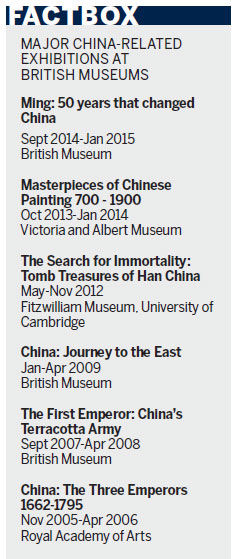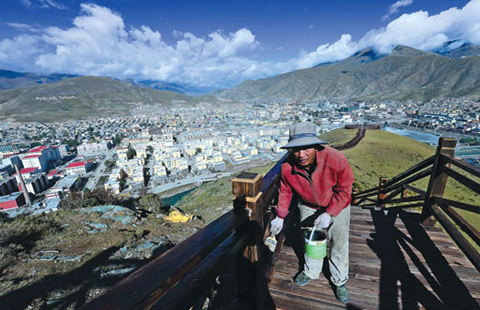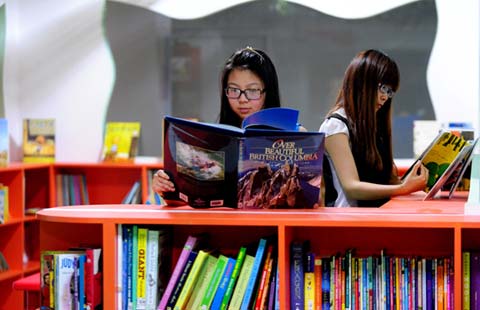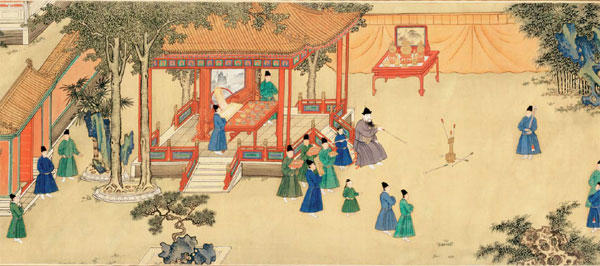A golden age for Chinese art
Updated: 2014-08-22 07:21
By Zhang Chunyan in London(China Daily Europe)
|
|||||||||||
|
One of the artworks from China's Ming Dynasty (1368-1644) that will be on show at the British Museum from September. Provided to China Daily |
The latest in a series of exhibitions focuses on bringing the best in ancient Chinese treasures to Britain
UK art experts are predicting a growth in interest in Chinese art and culture, driven by people's desire to view ancient pieces rarely seen before in the country.
From next month, a landmark exhibition of treasures from the golden age of Chinese history is to be put on at the British Museum. The curator says the exhibition will "dazzle" visitors.
Its focus is on how China became a superpower in the first half of the 15th century and the wealth of beautiful objects it produced during the Ming Dynasty (1368-1644), says its curator, Jessica Harrison-Hall. She adds that it is only now that British audiences are starting to fully understand Chinese art.
"The exhibition concentrates on 50 particular years, when China was becoming a global superpower," she explains.
"It is like our Elizabethan era - a golden age. Probably the most beautiful things ever made in China were made at this time.
"It will include priceless pieces of porcelain, silk robes, golden vessels and jewelry, weapons, paintings, furniture and arguably the world's first encyclopedia."
The event - Ming: 50 years that changed China - is being funded by a group of 10 Chinese institutions and 21 international lenders, and is also expected to feature new research as well as exhibits from that time in Chinese history.
"An understanding of this period is very beneficial for both people in China and the UK because there were so many echoes of the present at this time - this is a great opportunity to explore some of those relationships," Harrison-Hall adds.

Running until January, it has been given the official backing of the British Arts & Humanities Research Council - a non-departmental public body sponsored by the Department for Business, Innovation and Skills, along with the other UK research councils - which has meant academics from all over the world have been brought in to help.
The event will focus on five main themes: court, military and literary cultures, the distinction between beliefs and trade, and diplomacy.
One of the stars of the show will be the period's great Chinese mariner Zheng He.
"In Britain, people know about Vasco da Gama and Christopher Columbus, but know less about Zheng.
"It might surprise many to hear about some of his spectacular journeys - to East Africa and the Middle East - around the early 15th century.
"Even the Spanish ambassador to Samarkand, traditionally the second-largest city in Uzbekistan, was reported to have talked about the extraordinary beauty of China's crafts and how many people were involved in their production," says Harrison-Hall.
"This is a very rich and accessible period of Chinese history that is perhaps less well known than many others."
This latest major Chinese-themed event at the British Museum follows one from last October to January, Masterpieces of Chinese Painting 700-1900, held at the Victoria and Albert Museum, which brought together some fine examples, from small-scale intimate works by monks and literati to scrolls more than 14 meters long, many of which had never before been seen in the UK.
Zhang Hongxing, senior curator of the V&A, says: "The UK and the international media response has been so positive, with almost everyone admitting how little they actually knew about the Chinese art at this time.
"Exhibitions of this kind will hopefully play an important part in bringing a better understanding of historical China to the British public, in a way that the media brings them a growing understanding of present day, contemporary culture and society."
Zhang's opinion is echoed by Katie Hill, director of the Office of Contemporary Chinese Art, an artist representation agency which also specializes in sales, curating and in education regarding Chinese contemporary art.
"They are a sort of window for China, from an authentic prospective: Really high-quality Chinese culture coming to British audiences for the first time, allowing a view which they never normally have access to.
"When you actually see the range and variety of paintings, you realize the diversity of Chinese culture," says Hill.
She believes that the growing number of China-themed art exhibitions are especially significant today, because there is so much in the news about China that is problematic, or with a focus too often on trade or China's economic rise.
"China is very big in people's minds at the moment - but what is being said is often quite limited to business, manufacturing and economics," says Hill, adding that it has nothing much to do with the broader cultural aspects which many people have never had explained.
Art and cultural exhibitions offer access to pleasurable aspects of China, which are given little media coverage, offering what she says is crucial in bridging the cultural gap.
Curators are encouraged by some of the long-term relationships that have been developed between museums in China and Britain over the past 20 years, allowing experts from both sides to work together on events.
Another of those is Passion for Porcelain, an exhibition first held at China's National Museum in collaboration with the V&A and the British Museum, which was then moved to the Shanghai Museum, and the city's China Art Palace.
Zhang Hongxing says more exhibitions will be planned in Britain to enhance and increase everyone's knowledge about China.
"These are a really important means of communication, letting people understand about China and its history.
"If we introduce more about Chinese art to the world, then people will be given a wider perspective of the country, and in turn China can play a more important role in the art world."
Adds Harrison-Hall: "The more people understand each other's cultures, the more they can understand a country - that's particularly true in China, where an understanding of the past is so relevant to the present."
zhangchuyan@chinadaily.com.cn
( China Daily European Weekly 08/22/2014 page26)
Today's Top News
Telegram good gesture from Pope to China
Japanese firms face $200m fine
Ice Bucket Challenge hits China
Gaza ceasefire talks collapsed
Heinz recalls four batches of infant food in China
WHO says Ebola has killed more than 1,200
Japan looking to buy more stealth fighters
2 Air Force jets collide in Italy, 4 airmen missing
Hot Topics
Lunar probe , China growth forecasts, Emission rules get tougher, China seen through 'colored lens', International board,
Editor's Picks

|

|

|

|

|

|






